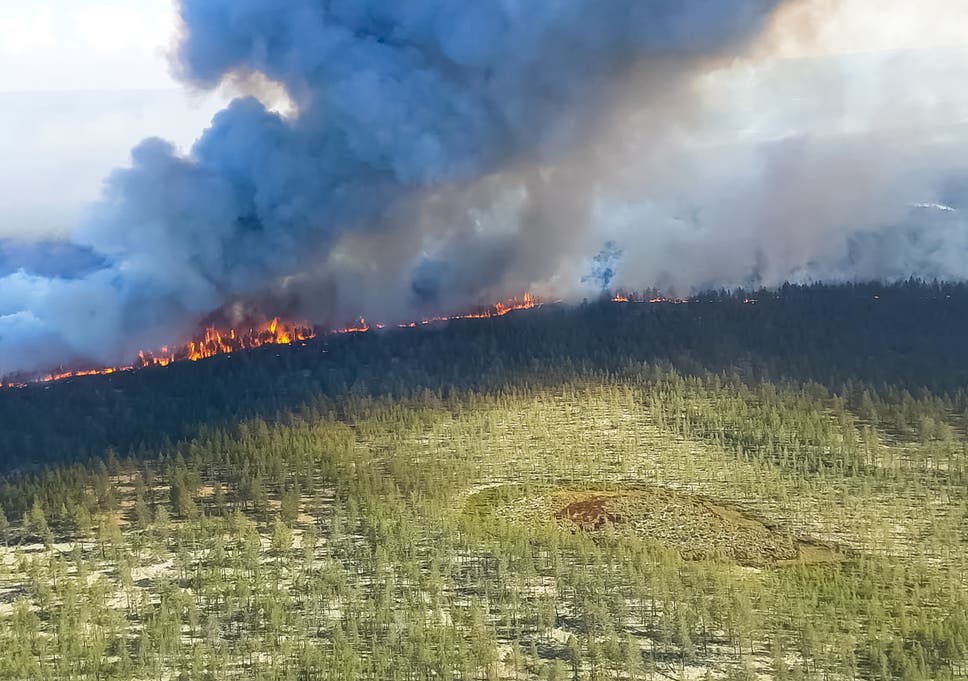
Siberia’s record-breaking heatwave is reportedly forecast to continue during July, raising the likelihood of worsening what are already among the worst wildfires ever known in the region, and further thawing the region’s vital permafrost.
Meteorologists said five Siberian regions, including one in the Arctic, will experience temperatures of 37 degrees Celsius over coming days, according to the Moscow Times.
The devastating heat comes after the Siberian town of Verkhoyansk reported what is believed to be the highest temperature ever known inside the Arctic Circle, of 38C earlier in June.
Meanwhile other parts of the Arctic have seen temperatures soar above 30C when the average for the time of year is still normally zero.
Overall temperatures in Arctic Siberia hit their highest ever average for June, more than 5C above normal, European Union data revealed this week.
“Heat waves in summer have always existed, but now, with climate change accelerating, they’re becoming longer and more frequent”, Alexey Kokorin, the head of the Climate and Energy programme at WWF Russia told the Moscow Times.
“Exceptional warmth” was recorded over Arctic Siberia, the EU's earth observation programme Copernicus said, as part of a trend scientists are calling a “warning cry”.
Average temperatures in the region were more than a degree higher than in June in the last two years, which previously held the records as the two warmest Junes ever.
“The climate is changing faster in the Arctic and we are getting drier and warmer conditions which are ideal conditions for wildfires to burn,” Mark Parrington, senior scientist at Copernicus, told Reuters.
The Russian forestry agency said that as of July 6, there were 246 forest fires covering 140,073 hectares and an emergency situation has been declared in seven regions.
Russian state TV footage this week showed planes dumping water near huge columns of white smoke.
Copernicus said the fires have surpassed the record number of blazes seen in the region in the same month of last year.
In 2019, the worst year on record for regional fires, the Russian forest agency said wildfires ripped through around 15 million hectares with damage estimated at more than 13 billion roubles (£145m).
Wildfire carbon dioxide emissions from the region last month were an estimated 59 megatonnes, compared with 53 megatonnes last year, the EU said.
But even this large figure could be an underestimate, as the satellite data Copernicus relies on is not thought to include all peat land, which tends to smoulder, not burn.
Scientists have warned the wildfires are contributing to climate change via feedback loops: burning peatlands are releasing carbon stored there for millennia and leaving soot deposits on snow and ice, reducing their ability to reflect the sun's heat. Meanwhile, sea ice is melting and not reforming to the same extent, allowing ever greater areas of the ocean to warm up. These process are part of the Arctic amplification phenomenon which is a key reason why the region is warming at least twice as fast as the rest of the world.
But warming in the Arctic has grave consequences for the rest of the planet, as ice-melt raises sea levels and alters the salinity of the oceans, and melting permafrost can release large amounts of methane - a potent greenhouse gas - into the atmosphere, further exacerbating warming.
“The big link that people need to make [is that the Arctic is] far away and it's sparsely populated but it still has a big impact on everybody,” Guido Grosse, at the Alfred Wegener Institute Helmholtz Centre for Polar and Marine Research, said.
In total, last year, wildfires in the Arctic Circle produced more than 170 megatonnes of emissions, exceeding the 2018 annual emissions of many countries.
The hot Siberian summer also comes immediately after the hottest winter since 1891, according to the Russian State Meteorological Service.
“The winter of 2019-20 became the warmest in Russia in the entire 130-year history of regular meteorological observations,” the organisation said, pointing out that the average air temperature in Moscow during winter exceeded 0C for the first time on record.
In just 30 years, the damage to the Russian economy from thawing permafrost could slash 8.5 per cent from the country’s GDP, according to Alexander Kislov, a researcher with the Geographical Faculty of Moscow State University, who was speaking to the state-run RIA Novosti news agency earlier this year.
Additional reporting by Reuters







